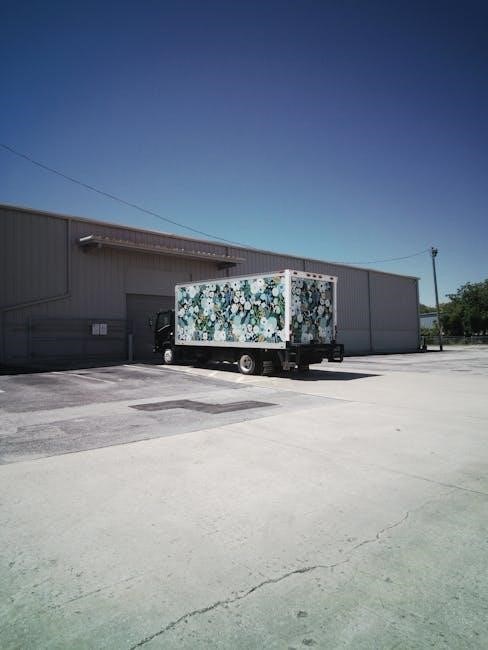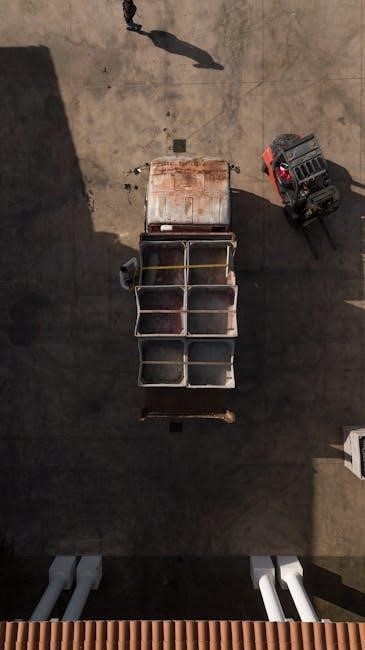Concrete mixer trucks are essential for transporting and mixing concrete on-site․ Understanding their dimensions is crucial for construction planning‚ logistics‚ and ensuring efficient operations on any project․
1․1 Importance of Understanding Mixer Truck Dimensions
Understanding concrete mixer truck dimensions is vital for logistics‚ site access‚ and operational efficiency․ Proper sizing ensures safe maneuvering‚ compliance with weight regulations‚ and optimal mixing capacity․ Accurate dimensions also prevent overloading and enhance safety features‚ reducing risks on construction sites․ This knowledge helps in selecting the right truck for specific projects‚ minimizing delays and waste․
1․2 Overview of Concrete Mixer Trucks and Their Applications
Concrete mixer trucks are specialized vehicles designed to transport and mix concrete․ They are widely used in construction projects‚ from residential to large-scale infrastructure․ These trucks ensure fresh concrete is delivered to sites‚ ready for pouring․ Their applications include foundations‚ roads‚ and structural projects‚ making them indispensable in modern construction for efficient and timely concrete placement․

Standard Dimensions of Concrete Mixer Trucks
Standard dimensions vary by model‚ but typical mixer trucks have a drum capacity of 8-12 cubic meters‚ overall lengths of 7-9 meters‚ and a loaded weight of 20-30 tons․
2․1 Drum Capacity and Mixing Volume
Concrete mixer trucks typically have drum capacities ranging from 8 to 12 cubic meters‚ with mixing volumes slightly less due to structural reinforcements․ This ensures efficient mixing and transport of concrete‚ accommodating various project scales while maintaining operational efficiency and load stability․
2․2 Overall Truck Length‚ Width‚ and Height
Concrete mixer trucks typically measure between 9 to 12 meters in length‚ 2․5 to 3․5 meters in width‚ and 3․8 to 4․2 meters in height․ These dimensions ensure mobility on urban roads and stability during transit․ They also facilitate compliance with regional transport regulations while accommodating various construction project requirements effectively․
2․3 Wheelbase and Turning Radius
Concrete mixer trucks typically have a wheelbase ranging from 4 to 5 meters‚ allowing for stability and maneuverability․ The turning radius is generally around 8 to 10 meters‚ enabling navigation in tight urban spaces․ These dimensions are critical for efficient operation and safety‚ ensuring the truck can move effectively on construction sites and public roads;

Types of Concrete Mixer Trucks and Their Dimensions
Concrete mixer trucks vary by size‚ including small‚ medium‚ and large models‚ each designed for specific applications and spaces‚ with dimensions tailored to their intended use․
3․1 Small-Size Mixer Trucks for Tight Spaces
Small-size mixer trucks are designed for maneuverability in tight spaces‚ offering compact dimensions for urban construction sites․ Their smaller drum capacity and reduced overall length enable easy navigation through narrow streets and restricted areas‚ making them ideal for smaller projects or remote locations where larger trucks cannot access․
3․2 Medium-Size Mixer Trucks for General Construction
Medium-size mixer trucks are versatile and widely used in general construction projects․ With a drum capacity of 6-8 cubic meters‚ they balance maneuverability and load capacity․ Their overall length‚ typically 7-8 meters‚ and wheelbase of 4-4․5 meters‚ make them suitable for urban and suburban sites․ These trucks are preferred for medium-scale projects due to their reliable performance and adaptability․
3․3 Large-Size Mixer Trucks for Industrial Projects
Large-size mixer trucks are designed for industrial-scale projects‚ offering drum capacities of 10-12 cubic meters․ Their overall length and width typically range from 9-10 meters and 2․5-3 meters‚ respectively‚ with a wheelbase of 5-5․5 meters․ These trucks have a turning radius of 7-8 meters and a height clearance of approximately 4 meters‚ ensuring maneuverability on large sites․ With a gross vehicle weight of up to 25-30 tons‚ they are ideal for high-volume concrete demands in infrastructure and industrial construction․

Safety Considerations and Dimensional Requirements
Safety considerations involve adhering to weight and load capacity regulations to prevent accidents․ Proper height clearance ensures trucks can safely navigate under bridges and through tight spaces․
4․1 Weight and Load Capacity Regulations
Weight and load capacity regulations ensure mixer trucks operate safely․ Typical concrete weight is 2400 kg/m³‚ with trucks designed to carry loads without exceeding legal limits‚ ensuring stability and safety on roads․
4․2 Height Clearance and Bridge Restrictions
Concrete mixer trucks must adhere to height clearance and bridge restrictions to avoid damage or safety hazards․ Typical heights range between 3․8 to 4․2 meters‚ requiring careful route planning to navigate low bridges or overpasses․ Non-compliance can lead to operational delays or legal penalties‚ emphasizing the need for precise dimensional awareness in construction logistics․
4․3 Safety Features Related to Truck Dimensions
Safety features in concrete mixer trucks are designed to prevent accidents and ensure secure operation․ These include emergency stop systems‚ reflective markings‚ and rearview cameras․ Proper dimensional design enhances visibility and stability‚ reducing rollover risks․ Stabilizers and ergonomic controls further improve safety‚ making the trucks safer for operators and road users while adhering to regulatory standards․
Regional Variations in Mixer Truck Dimensions
Concrete mixer truck dimensions vary by region due to local regulations‚ infrastructure‚ and construction demands․ European‚ North American‚ and Asian markets each have unique standards influencing design and size․
5․1 European Standards and Dimensions
European concrete mixer trucks often feature compact designs due to narrow city streets and strict emissions regulations․ Dimensions are optimized for maneuverability‚ with lower height clearances and shorter wheelbases․ Weight and load capacities are closely regulated to prevent overloading‚ ensuring road safety and compliance with EU directives․ These standards emphasize efficiency and environmental sustainability‚ aligning with regional construction demands․
5․2 North American Standards and Dimensions
North American concrete mixer trucks typically feature larger dimensions due to wider roads and heavier construction demands․ They adhere to strict regulations set by the Department of Transportation (DOT)‚ focusing on weight limits and axle loads․ These trucks often have higher load capacities and are designed for both on-road and off-road sites‚ ensuring durability and efficiency in diverse construction environments․
5․3 Asian Standards and Dimensions
Asian countries like China‚ India‚ and Japan have standardized mixer truck dimensions tailored to local construction needs․ These trucks often feature modular designs‚ with compact drum sizes for urban areas․ Emission regulations and fuel efficiency are prioritized‚ alongside lightweight materials to enhance maneuverability․ Regional load capacities are optimized for diverse construction projects‚ ensuring adaptability in densely populated regions․

Environmental Impact of Mixer Truck Dimensions
Concrete mixer trucks’ dimensions affect environmental factors such as fuel efficiency and emissions․ Their size influences fuel consumption‚ increasing emissions and costs‚ while noise pollution disrupts communities‚ necessitating regulations․
6․1 Fuel Efficiency and Emissions
Concrete mixer truck dimensions significantly influence fuel efficiency and emissions․ Larger trucks‚ while capable of carrying more concrete‚ often consume more fuel and emit higher levels of CO2․
Stricter emissions regulations‚ such as Euro 6 standards‚ are driving manufacturers to develop more efficient engines and reduce environmental impact without compromising mixing capacity or operational performance․
6․2 Noise Pollution and Operational Constraints
Concrete mixer trucks generate significant noise from their engines and rotating drums‚ posing challenges in urban areas․ Stricter noise regulations may limit operational hours‚ especially in residential zones․ Manufacturers are exploring quieter engine technologies and sound-dampening materials to minimize disruption while maintaining efficiency and performance․

Future Trends in Concrete Mixer Truck Design
Future trends include electric and autonomous mixer trucks‚ reducing emissions and enhancing safety․ Modular designs and advanced materials will improve efficiency and environmental sustainability in concrete transportation․
7․1 Autonomous and Electric Mixer Trucks
Autonomous and electric mixer trucks are emerging as sustainable solutions․ These vehicles reduce emissions‚ enhance safety‚ and improve operational efficiency․ Autonomous navigation systems optimize delivery routes‚ while electric motors lower environmental impact․ Advanced technologies enable precise mixing and real-time monitoring‚ ensuring consistent concrete quality․ These innovations are reshaping the future of construction logistics and materials transportation․
7․2 Modular and Adjustable Mixer Trucks
Modular and adjustable mixer trucks offer flexibility in construction projects․ Their customizable design allows adaptation to various job requirements‚ improving efficiency․ Adjustable drum sizes and chute systems enable precise concrete delivery․ These trucks reduce logistical challenges and enhance site adaptability‚ making them ideal for diverse projects while minimizing costs and environmental impact through optimized resource use․

Maintenance and Dimensional Accuracy
Regular maintenance ensures optimal performance and longevity of mixer trucks․ Dimensional accuracy is critical for precise concrete mixing and delivery‚ requiring consistent calibration and inspection routines․
8;1 Regular Maintenance Checks
Regular maintenance checks are vital for ensuring mixer trucks operate efficiently․ Inspections should include drum rotation‚ hydraulic systems‚ and tire condition․ Lubrication of moving parts and cleaning the mixing drum are essential․ Proper maintenance prevents mechanical failures and ensures dimensional accuracy‚ which is critical for consistent concrete quality and safe operation․ Schedule checks as per manufacturer guidelines to maintain performance and longevity․
8․2 Calibration of Mixing Drum Dimensions
Calibrating the mixing drum dimensions ensures accurate measurements and consistent concrete quality․ Regular checks involve verifying drum capacity‚ internal dimensions‚ and blade alignment․ Adjustments must align with manufacturer specifications to maintain precision․ Proper calibration prevents issues like overmixing or undermixing‚ ensuring the final product meets project requirements․ Schedule calibration periodically to uphold operational efficiency and dimensional accuracy․
Legal and Regulatory Framework
Concrete mixer trucks must comply with legal standards regulating weight‚ emissions‚ and safety․ Adherence to these regulations ensures public safety and environmental protection during operations․
9․1 Permits and Dimensional Restrictions
Concrete mixer trucks require specific permits and must adhere to dimensional restrictions to ensure safe operation․ These regulations often include weight limits‚ emissions standards‚ and safety features to protect public roads and the environment;
9․2 Compliance with International Standards
Concrete mixer trucks must comply with international standards to ensure safety‚ efficiency‚ and environmental sustainability․ These standards often include specifications for design‚ emissions‚ and operational limits‚ ensuring trucks meet global safety and performance benchmarks; Adherence to these standards facilitates seamless operation across borders and helps meet legal and environmental regulations worldwide․
Understanding concrete mixer truck dimensions is vital for efficient construction planning‚ safety‚ and compliance with regulations‚ ensuring optimal performance in various projects and environments globally․
10․1 Summary of Key Points
Concrete mixer truck dimensions are crucial for construction logistics‚ varying by size and region․ Standard specs ensure efficiency‚ while safety and environmental factors guide design․ Future trends focus on autonomy and sustainability‚ emphasizing the need for precise dimensional planning and maintenance to optimize performance across diverse projects and regulatory environments globally․
10․2 Final Thoughts on Mixer Truck Dimensions
Concrete mixer truck dimensions play a pivotal role in construction logistics‚ influencing efficiency‚ safety‚ and environmental impact․ While regional standards vary‚ adherence to safety protocols and sustainable practices remains universal․ As technology advances‚ future designs will likely prioritize autonomy and eco-friendliness‚ ensuring mixer trucks continue to meet evolving construction demands effectively and responsibly․


